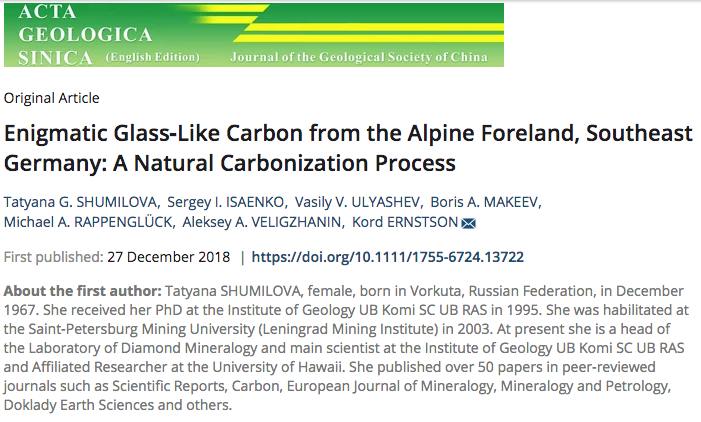Abstract: Unusual carbonaceous matter, termed here chiemite, composed of more than 90% C from the Alpine Foreland at Lake Chiemsee in Bavaria, southeastern Germany has been investigated using optical and atomic force microscopy, X‐ray fluorescence spectroscopy, scanning and transmission electron microscopy, high‐resolution Raman spectroscopy, X‐ray diffraction and differential thermal analysis, as well as by δ13C and 14C radiocarbon isotopic data analysis. In the pumice‐like fragments, poorly ordered carbon matter co‐exists with high‐ordering monocrystalline α‐carbyne, and contains submicrometer‐sized inclusions of complex composition. Diamond and carbyne add to the peculiar mix of matter. The required very high temperatures and pressures for carbyne formation point to a shock event probably from the recently proposed Holocene Chiemgau meteorite impact. The carbon material is suggested to have largely formed from heavily shocked coal, vegetation like wood, and peat from the impact target area. The carbonization/coalification high PT process may be attributed to a strong shock that instantaneously caused the complete evaporation and loss of volatile matter and water, which nevertheless preserved the original cellular structure seen fossilized in many fragments. Relatively fresh wood encapsulated in the purported strongly shocked matter point to quenched carbon melt components possibly important for the discussion of survival of organic matter in meteorite impacts, implying an astrobiological relationship.
Zusammenfassung: – Ungewöhnliche Kohlenstoff-Materie aus mehr als 90% C, hier Chiemit genannt, aus dem Alpenvorland am Chiemsee in Bayern, wurde mit optischer und Rasterkraftmikroskopie, Röntgenfluoreszenzspektroskopie, Raster- und Transmissionselektronenmikroskopie, hochauflösender Raman-Spektroskopie, Röntgenbeugung und Differentialthermoanalyse sowie mit δ13C und 14C Radiokohlenstoff-Isotopendatenanalyse untersucht. In den bimssteinähnlichen Fragmenten koexistiert schlecht geordnete Kohlenstoffsubstanz mit hochrangig monokristallinem α-Carbin und enthält submikrometergroße Einschlüsse komplexer Zusammensetzung. Diamant und Carbine tragen zur eigenartigen Mischung der Materie bei. Die für die Bildung von Carbinen erforderlichen sehr hohen Temperaturen und Drücke deuten auf ein Schockereignis hin, das wahrscheinlich auf den kürzlich vorgeschlagenen holozänen Meteoriteneinschlag im Chiemgau zurückzuführen ist. Es wird angenommen, dass sich das Kohlenstoffmaterial weitgehend aus stark geschockter Kohle, Vegetation wie Holz und Torf aus dem Einschlaggebiet gebildet hat. Der Hochdruck-/Hochtemperatur-Prozess der Karbonisierung/Inkohlung kann auf einen starken Schock zurückgeführt werden, der sofort die vollständige Verdampfung und den Verlust von flüchtigen Bestandteilen und Wasser verursachte, die jedoch die ursprüngliche Zellstruktur bewahrten, die fossil in vielen Fragmenten zu beobachten ist. Relativ frisches Holz, das in der vorgeschlagenen stark geschockten Materie eingekapselt ist, weist auf abgeschreckte Komponenten einer Kohlenstoffschmelze hin, was für die Diskussion über das Überleben organischer Substanzen bei Meteoriteneinschlägen möglicherweise wichtig ist und eine astrobiologische Beziehung haben kann.



































